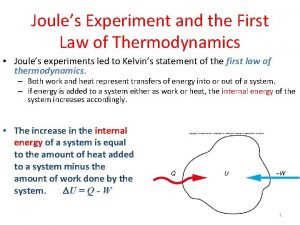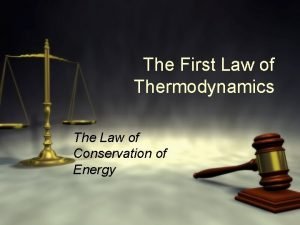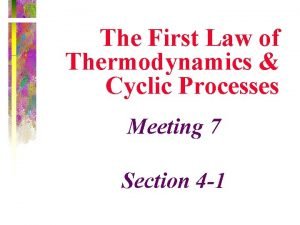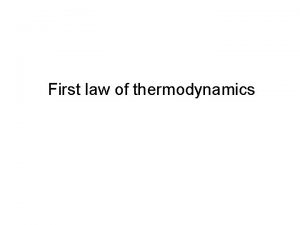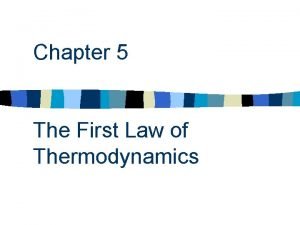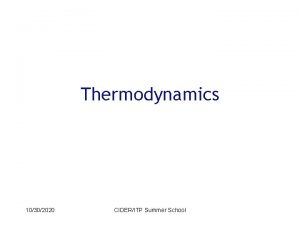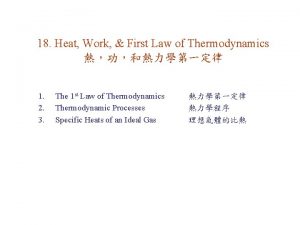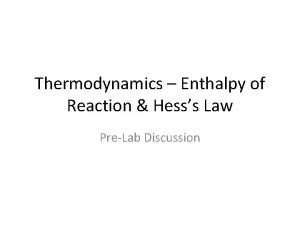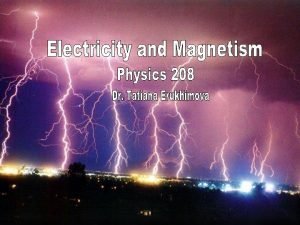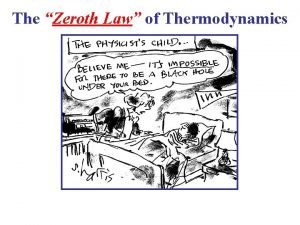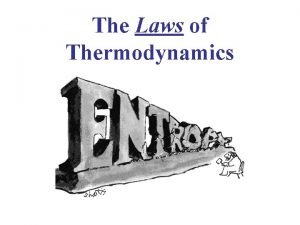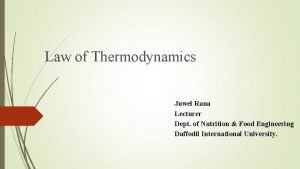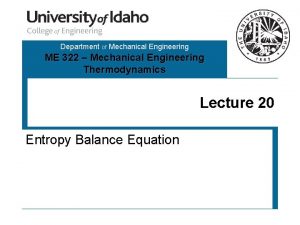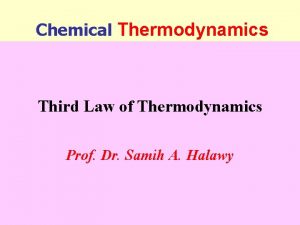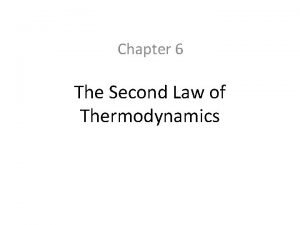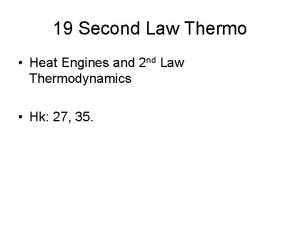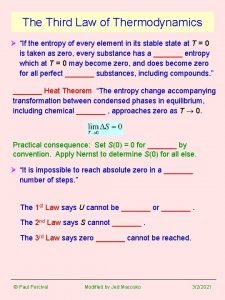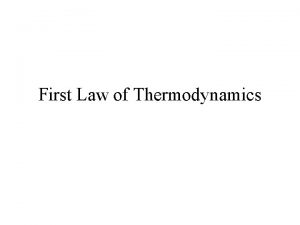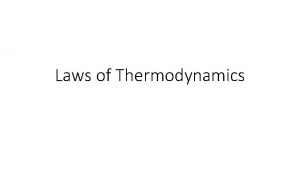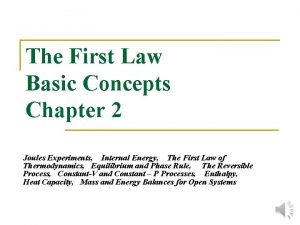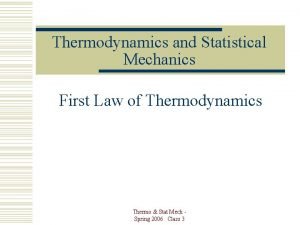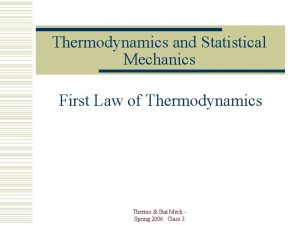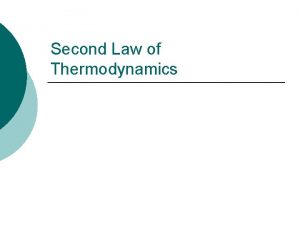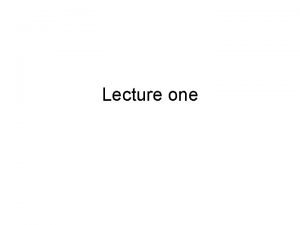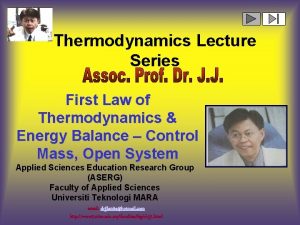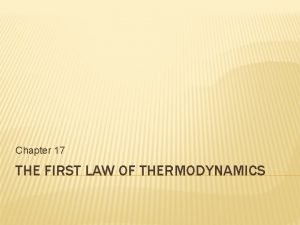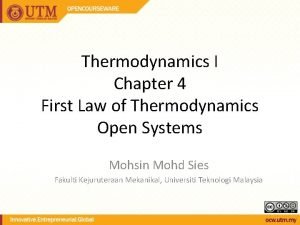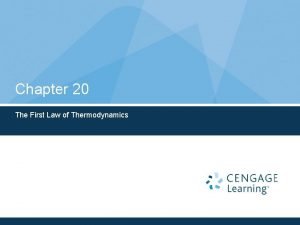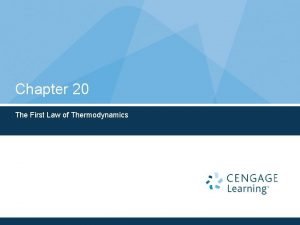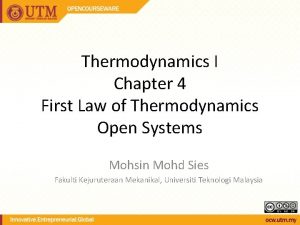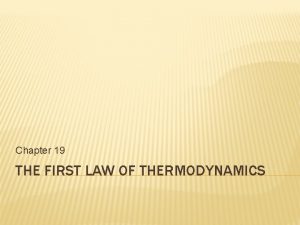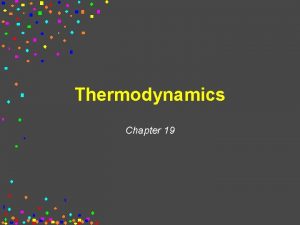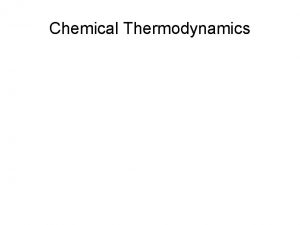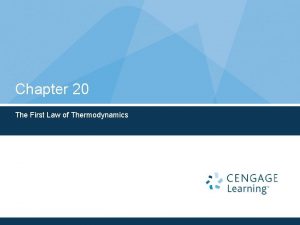Joules Experiment and the First Law of Thermodynamics























- Slides: 23

Joule’s Experiment and the First Law of Thermodynamics • Joule’s experiments led to Kelvin’s statement of the first law of thermodynamics. – Both work and heat represent transfers of energy into or out of a system. – If energy is added to a system either as work or heat, the internal energy of the system increases accordingly. • The increase in the internal energy of a system is equal to the amount of heat added to a system minus the amount of work done by the system. U = Q - W 1

The Flow of Heat • There are three basic processes for heat flow: – Conduction – Convection – Radiation 2

3 D-05 Solar Panel 3 D-03 Radiation--Match http: //www. youtube. com/watch? v=w 5 lo i. W 3 STz. U&feature=results_main&playnex t=1&list=PLFA 6 F 13 ACB 19 C 86 BF "Archimedes heat ray", was used to focus sunlight 3 onto approaching ships, causing them to catch fire.

3 B-04 Boiling Water in Cup When there’s water inside, will the paper cup burn? A. yes. B. No. 4

– To minimize heat loss • Minimize all three kind of heat exchange. 5

Quiz When there’s NO water inside, will the paper cup burn? A. yes. B. No. 6

Heat Engines A gasoline engine is a form of a heat engine, e. g. a 4 -stroke engine INTAKE stroke: the piston descends from the top to the bottom of the cylinder, reducing the pressure inside. A mixture of fuel and air, is forced by atmospheric pressure into the cylinder through the intake port. The intake valve then close. COMPRESSION stroke: with both intake and exhaust valves closed, the piston returns to the top of the cylinder compressing the fuel-air mixture. POWER stroke: the compressed air–fuel mixture in a gasoline engine is ignited by a spark plug. The compressed fuel-air mixture expand move the piston back EXHAUST stroke: during the exhaust stroke, the piston once again returns to top while the exhaust valve is open and expel the spent fuelair mixture out through the exhaust valve(s). 7

3 E 09, 3 E 10, 2 E 12 Engines Stirling Engine running on a cup of hot water: • When the yellow foam inside the engine is near the top of the cylinder most of the air is on the bottom side (the hot side) where it is heated. • When the air gets hot it expands and pushes up on the piston. When the foam moves to the bottom of the engine it moves most of the air to the top of the engine. • The top of the engine is cool, allowing the air inside the engine to cool off (reject heat to the environment) and • Steam the piston receives a downward push. Engine 8

3 E 09, 3 E 10, 2 E 12 Engines 1. A fire where the coal burns. Stirling Engine 2. A boiler full of water that the fire heats up to make steam. 3. A cylinder and piston. Steam from the boiler is piped into the cylinder, causing the piston to move first one way then the other. This in and out movement (which is also known as "reciprocating") is used to drive. . . 4. Steam A machine attached to the piston. That Engine could be anything from a water pump to a factory machine. . . or even a giant steam locomotive running up and down a railroad. 9

Efficiency • Efficiency is the ratio of the net work done by the engine to the amount of heat that must be supplied to accomplish this work. 10

A heat engine takes in 1200 J of heat from the high -temperature heat source in each cycle, and does 400 J of work in each cycle. What is the efficiency of this engine? a) b) c) 33% 40% 66% QH = 1200 J W = 400 J e = W / QH = (400 J) / (1200 J) = 1/3 = 0. 33 = 33% 11

How much heat is released into the environment in each cycle? a) b) c) d) 33 J 400 J 800 J 1200 J QC = QH - W = 1200 J - 400 J = 800 J 12

Carnot Engine • The efficiency of a typical automobile engine is less than 30%. – This seems to be wasting a lot of energy. – What is the best efficiency we could achieve? – What factors determine efficiency? • The cycle devised by Carnot that an ideal engine would have to follow is called a Carnot cycle. • An (ideal, not real) engine following this cycle is called a Carnot engine. 13

Different Thermal Process • If the process is adiabatic, no heat flows into or out of the gas • In an isothermal process, the temperature does not change. – The internal energy must be constant. – The change in internal energy, U, is zero. – If an amount of heat Q is added to the gas, an equal amount of work W will be done by the gas on its surroundings, from U = Q - W. • In an isobaric process, the pressure of the gas remains constant. – The internal energy increases as the gas is heated, and so does the temperature. – The gas also expands, removing some of the internal energy. • Experiments determined that the pressure, volume, and absolute temperature of an ideal gas are related by the equation of state: PV = Nk. T where N is the number of molecules and k is Boltzmann’s constant. 14

1. Heat flows into cylinder at temperature TH. The fluid expands isothermally and does work on the piston. 2. The fluid continues to expand, adiabatically. 3. Work is done by the piston on the fluid, which undergoes an isothermal compression. 4. The fluid returns to its initial condition by an adiabatic compression. 15

Carnot Efficiency • The efficiency of Carnot’s ideal engine is called the Carnot efficiency and is given by: • This is the maximum efficiency possible for any engine taking in heat from a reservoir at absolute temperature TH and releasing heat to a reservoir at temperature TC. – The temperature must be measured in absolute degrees. • Even Carnot’s ideal engine is less than 100% efficient. 16

A steam turbine takes in steam at a temperature of 400 C and releases steam to the condenser at a temperature of 120 C. What is the Carnot efficiency for this engine? a) b) c) d) 30% 41. 6% 58. 4% 70% TH = 400 C = 673 K TC = 120 C = 393 K e. C = (TH - TC ) / TH = (673 K - 393 K) / (673 K) = 280 K / 673 K = 0. 416 = 41. 6% 17

Quiz: If the turbine takes in 500 k. J of heat in each cycle, what is the maximum amount of work that could be generated by the turbine in each cycle? a) b) c) d) 0. 83 J 16. 64 k. J 28 k. J 208 k. J 18

Entropy • 19

Treat the room, the cup and the water and ice as one single system. The net change of the system entropy is: 0. 366 -0. 336 = 0. 03 J/k, i. e. entropy is not a conservative quantity. It increased during this process. The above heat exchange process is a spontaneous process. One can make a more general statement: “entropy of an isolated system, i. e. no heat exchange with other systems, always increases, and processes which increase entropy can occur spontaneously”. This is the second law of thermodynamics. 20

Heat Pumps, and Entropy • If a heat engine is run in reverse, then work W is done on the engine as heat QC is removed from the lower-temperature reservoir and a greater quantity of heat QH is released to the highertemperature reservoir. • A device that moves heat from a cooler reservoir to a warmer reservoir by means of work supplied from some external source is called a heat pump. 21

Refrigerators and Heat Pumps • A refrigerator is also a form of a heat pump. • It also moves heat from a cooler reservoir to a warmer reservoir by means of work supplied from some external source. • It keeps food cold by pumping heat out of the cooler interior of the refrigerator into the warmer room. • An electric motor or gas-powered engine does the necessary work. 22

Quiz: A heat pump uses 200 J of work to remove 300 J of heat from the lower-temperature reservoir. How much heat would be delivered to the higher-temperature reservoir? a) b) c) d) 100 J 200 J 300 J 500 J 23
 The joule experiment
The joule experiment Newton's first law and second law and third law
Newton's first law and second law and third law Newton's first law of motion
Newton's first law of motion Sssf thermodynamics
Sssf thermodynamics Isobaric process formula
Isobaric process formula 1th law of thermodynamics
1th law of thermodynamics First law of thermodynamics
First law of thermodynamics In a flow process the work transfer may be of which type
In a flow process the work transfer may be of which type First law of thermodynamics sign convention
First law of thermodynamics sign convention First law of thermodynamics control mass
First law of thermodynamics control mass Free energy
Free energy Thermodynamics of ideal gases
Thermodynamics of ideal gases Thermodynamics enthalpy of reaction and hess's law
Thermodynamics enthalpy of reaction and hess's law Tatiana erukhimova
Tatiana erukhimova Thermodynamic
Thermodynamic Law of thermodynamics in chemistry
Law of thermodynamics in chemistry Third law of thermodynamics
Third law of thermodynamics Second law of thermodynamics
Second law of thermodynamics State second law of thermodynamics
State second law of thermodynamics What is second law of thermodynamics
What is second law of thermodynamics Thermodynamics rules
Thermodynamics rules Second law of thermodynamics
Second law of thermodynamics Second law of thermodynamics
Second law of thermodynamics Third law of thermodynamics is depend on
Third law of thermodynamics is depend on
